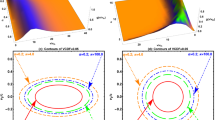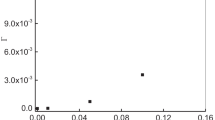Abstract
The growing rate of bump-on-tail instability has been investigated in unmagnetized plasma with Cairns distribution. The growing rate depends significantly on the number density ratio n1/n2, temperature ratio T1/T2, and the nonthermal parameter α. The influence of these parameters on the maximum growing rate is analyzed numerically by using solar data. The higher α can enhance the growing rate of bump-on-tail instability. The maximum growth rate also will increase with the decrease of number density ratio n1/n2 and the increase of temperature ratio T1/T2. These interesting results will be helpful for understanding some phenomena in space plasma.




Similar content being viewed by others
Data Availability
Data sharing is not applicable to this article as no new data were created or analyzed in this study.
References
N.A. Krall, A.W. Trivelpiece, Principles of plasma physics (McGraw Hill, New York, 1973)
K. Papadopoulos, M.L. Goldstein, R.A. Smith, Stabilization of electron streams in type III solar radio bursts. Astrophys. J. 190, 175 (1974). https://doi.org/10.1086/152862
H.P. Freund, R.A. Smith, K. Papadopoulos, Modulational instability in a plasma with suprathermal electrons. Phys. Fluids 24, 442 (1981). https://doi.org/10.1063/1.863390
A.J. Klimas, R.J. Fitzenreiter, On the persistence of unstable bump-on-tail electron velocity distributions in the Earth’s foreshock. J. Geophys. Res. 93, 9628 (1988). https://doi.org/10.1029/JA093iA09p09628
F. Valentini, P. Veltri, Effect of velocity diffusion on the propagation of nonlinear plasma waves Europhys. Lett. 81, 150012 (2008). https://doi.org/10.1209/0295-5075/81/15002
I. Zouganelis, Measuring suprathermal electron parameters in space plasmas: implementation of the quasi-thermal noise spectroscopy with kappa distributions using in situ Ulysses/URAP radio measurements in the solar wind. J. Geophys. Res. 113, A08111 (2008). https://doi.org/10.1029/2007JA012979
J. Du, Nonextensivity in nonequilibrium plasma systems with Coulombian long-range interactions. Phys. Lett. A 329, 262 (2004). https://doi.org/10.1016/j.physleta.2004.07.010
V.M. Vasyliunas, A survey of low-energy electrons in the evening sector of the magnetosphere with OGO 1 and OGO 3. J. Geophys. Res. 73, 2839 (1968). https://doi.org/10.1029/JA073i009p02839
M.N.S. Qureshi, S.H.I. Jian-Kui, M.A. Shi-Zhuang, Influence of generalized (r, q) distribution function on electrostatic waves. Theor. Phys. 45, 550 (2006). https://doi.org/10.1088/0253-6102/45/3/034
R.A. Cairns, R. Bingham, R.O. Dendy et al., Ion sound solitary waves with density depressions. Le J. de Phys. IV 5, 6 (1995). https://doi.org/10.1051/jp4:1995608
Z. Liu, L. Liu, J. Du, A nonextensive approach for the instability of current-driven ion-acoustic waves in space plasmas Phys. Plasmas 16, 072111 (2009). https://doi.org/10.1063/1.3176516
J. Du, Transport coefficients in Lorentz plasmas with the power-law kappa distribution. Phys. Plasmas 20, 092901 (2013). https://doi.org/10.1063/1.4820799
S. Sarkar, S. Paul, R. Denra, Bump-on-tail instability in space plasmas. Phys. Plasmas 22, 102109 (2015). https://doi.org/10.1063/1.4933041
N. Noreen, A. Shiekh, I. Habumugisha, S. Zaheer, H. Shah, Linear analysis of bump on tail instability with non-Maxwellian distribution function. Plasma Res. Express 2, 025006 (2020). https://doi.org/10.1088/2516-1067/ab8e2b
K. Issautier, C. Perche, S. Hoang, C. Lacombe, M. Maksimovic, J. Bougeret, C. Salem, Solar wind electron density and temperature over solar cycle 23: thermal noise measurements on wind. Adv. Space Res. 35, 2141 (2005). https://doi.org/10.1016/j.asr.2005.04.085
K. Issautier, G. Le Chat, N. Meyer-Vernet, M. Moncuquet, S. Hoang, R.J. MacDowall, D.J. McComas, Electron properties of high-speed solar wind from polar coronal holes obtained by Ulysses thermal noise spectroscopy: not so dense, not so hot. Geophys. Res. Lett. 35, 19101 (2008). https://doi.org/10.1029/2008GL034912
M. Usman Malik, W. Masood, Arshad M. Mirza, Unique features of parallel whistler instability in a plasma with anisotropic Cairns distribution. Phys. Plasmas 24, 102120 (2017). https://doi.org/10.1063/1.4998774
I.A. Khan, Z. Iqbal, H. Naim, G. Murtaza, Obliquely propagating magnetosonic waves in a plasma modeled by bi-anisotropic Cairns distribution. Phys. Plasmas 25, 082111 (2018). https://doi.org/10.1063/1.5046556
F. Verheest, S.R. Pillay, Large amplitude dust-acoustic solitary waves and double layers in nonthermal plasmas. Phys. Plasmas 15, 013703 (2008). https://doi.org/10.1063/1.2831025
R. Sabry, W.M. Moslem, P.K. Shukla, Fully nonlinear ion-acoustic solitary waves in a plasma with positive-negative ions and nonthermal electrons. Phys. Plasmas 16, 032302 (2009). https://doi.org/10.1063/1.3088005
F. Hadi, A.U.R. Ata-Ur-Rahman, A. Qamar, Landau damping of electrostatic modes in nonthermal plasmas. Phys. Plasmas 24, 104503 (2017). https://doi.org/10.1063/1.5006802
M. Aman-ur-Rehman, M. Ahmad, M. Shahzad, Revisiting some analytical and numerical interpretations of Cairns and Kappa-Cairns distribution functions. Phys. Plasmas 27, 100901 (2020). https://doi.org/10.1063/5.0018906
K. Issautier, N.M. Vernet, M. Moncuquet, S. Hoang, Solar wind radial and latitudinal structure: electron density and core temperature from Ulysses thermal noise spectroscopy. J. Geophys. Res. 103, 1969 (1998). https://doi.org/10.1029/97JA02661
Author information
Authors and Affiliations
Contributions
all authors wrote the main manuscript text. All authors reviewed the manuscript.
Corresponding author
Ethics declarations
Competing Interests
The authors declare no competing interests.
Additional information
Publisher's Note
Springer Nature remains neutral with regard to jurisdictional claims in published maps and institutional affiliations.
Appendix
Appendix
The real part of the dispersion relation is expressed as
For electrons, in the case \(\omega /kv_{T} \gg 1\), the integral term in the dispersion relation can be approximated as
Combining Eq. (A2) and (A3), we can get
Assuming the cases, i.e., \(n_{1} \gg n_{2}\), \(n_{1} T_{1} \gg n_{2} m_{e} v_{0}^{2}\), then we can get
where we have used \(\lambda_{{D{1}}}^{2} = v_{{T{1}}}^{2} /\omega_{{p{1}}}^{{2}}\).
Rights and permissions
Springer Nature or its licensor (e.g. a society or other partner) holds exclusive rights to this article under a publishing agreement with the author(s) or other rightsholder(s); author self-archiving of the accepted manuscript version of this article is solely governed by the terms of such publishing agreement and applicable law.
About this article
Cite this article
Rui, H., Hong, W. Bump-on-Tail Instability in Cairns Distributed Plasma. Braz J Phys 54, 111 (2024). https://doi.org/10.1007/s13538-024-01481-3
Received:
Accepted:
Published:
DOI: https://doi.org/10.1007/s13538-024-01481-3




